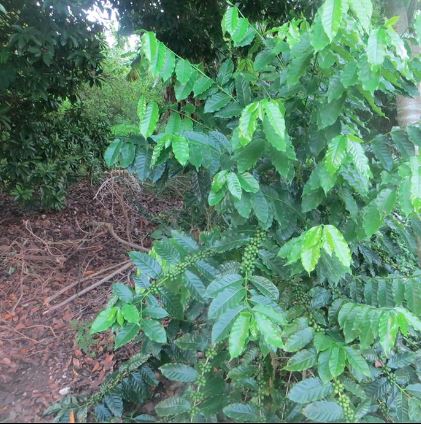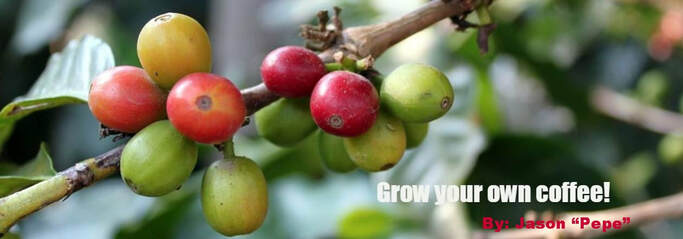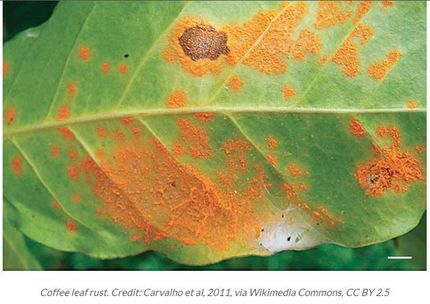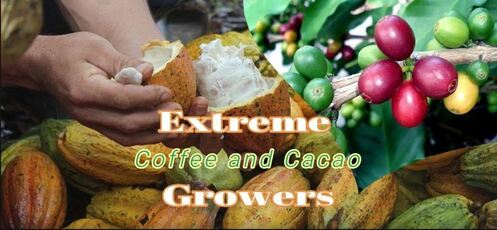Coffee Diseases
 Image by: Jonathan Gambino Three Sisters Farm
Image by: Jonathan Gambino Three Sisters Farm
La Roya is one mean devastating fungus! This little fungal monster has been around since 1870 and wiped out coffee plantations in Africa. One hundred plus years later it struck again and more recently it has spread to all parts of Latin America. The fungus has been controlled over the years by the use of powerful fungicides.
Once La Roya hits a coffee tree it causes yellow orange lesions on the leaves. Trees gradually become defoliated and cherries fall to the ground. The La Roya spores are dispersed by wind and rain moving across infected leaves and cherries.
A tree without leaves can not produce energy and eventually dies. Infected trees can't be cured, they must be burned. La Roya has caused billions of dollars in losses to coffee farmers and has resulted in lost income to field workers.
Some scientist like University of Michigan ecologist John Vandermeer believe that man has contributed to the widespread presence and severity of La Roya. He suggests that the heavy use of pesticides and the increasing practice of growing coffee in full sun are the culprits.
In a natural shaded environment coffee benefits from the diversity of the ecosystem. For example
White halo fungus, which is known to attack insects and help keep coffee rust fungus in check does not seem to be found in large numbers in open sun grown coffee plantations. White Halo fungus is a natural, beneficial, mycoparasitic predator that feeds on Hemileia vastatrix the La Roya fungus.
Could the solution to La Roya be a more natural, diverse, shaded coffee growing habitat?
I think so and here is a photo of a coffee tree growing under a sapodilla tree, partially filtering the light. Additionally it is surrounded by banana, acerola, jaboticaba, papaya and many other edible plants. The tree grows at Three Sisters Farm in Homestead, Florida. The farm is 100% organic and follows permaculture principals. This is one very healthy productive coffee tree full of cherries.
Once La Roya hits a coffee tree it causes yellow orange lesions on the leaves. Trees gradually become defoliated and cherries fall to the ground. The La Roya spores are dispersed by wind and rain moving across infected leaves and cherries.
A tree without leaves can not produce energy and eventually dies. Infected trees can't be cured, they must be burned. La Roya has caused billions of dollars in losses to coffee farmers and has resulted in lost income to field workers.
Some scientist like University of Michigan ecologist John Vandermeer believe that man has contributed to the widespread presence and severity of La Roya. He suggests that the heavy use of pesticides and the increasing practice of growing coffee in full sun are the culprits.
In a natural shaded environment coffee benefits from the diversity of the ecosystem. For example
White halo fungus, which is known to attack insects and help keep coffee rust fungus in check does not seem to be found in large numbers in open sun grown coffee plantations. White Halo fungus is a natural, beneficial, mycoparasitic predator that feeds on Hemileia vastatrix the La Roya fungus.
Could the solution to La Roya be a more natural, diverse, shaded coffee growing habitat?
I think so and here is a photo of a coffee tree growing under a sapodilla tree, partially filtering the light. Additionally it is surrounded by banana, acerola, jaboticaba, papaya and many other edible plants. The tree grows at Three Sisters Farm in Homestead, Florida. The farm is 100% organic and follows permaculture principals. This is one very healthy productive coffee tree full of cherries.
Back to Growing Coffee Page
|
|
* FDA Disclaimer
The products and statements made about specific plants or products on this web site have not been evaluated by the United States Food and Drug Administration (FDA) and are not intended to diagnose, treat, cure or prevent disease. All information provided on this web site or any information contained on or in any product label or packaging is for informational purposes only and is not intended as a substitute for advice from your physician or other health care professional. You should not use the information on this web site for diagnosis or treatment of any health problem. Always consult with a healthcare professional before starting any new vitamins, supplements, diet, or exercise program, before taking any medication, or if you have or suspect you might have a health problem.
Advertising Disclosure:
Pepesplants.com is a participant in the Amazon Services LLC Associates Program and also Googles affiliate advertising program. The programs provide a means for web sites to earn revenues from advertising and or sales.
Content Disclosure
Use all information on this site at your own risk.
The content here is based on the publishers personal experience in the green industries.
Although every reasonable effort has been made to ensure the accuracy of the information contained on this site, absolute accuracy cannot be guaranteed. This site, and all information and materials appearing on it, are presented to the user "as is" without warranty of any kind, either express or implied
The products and statements made about specific plants or products on this web site have not been evaluated by the United States Food and Drug Administration (FDA) and are not intended to diagnose, treat, cure or prevent disease. All information provided on this web site or any information contained on or in any product label or packaging is for informational purposes only and is not intended as a substitute for advice from your physician or other health care professional. You should not use the information on this web site for diagnosis or treatment of any health problem. Always consult with a healthcare professional before starting any new vitamins, supplements, diet, or exercise program, before taking any medication, or if you have or suspect you might have a health problem.
Advertising Disclosure:
Pepesplants.com is a participant in the Amazon Services LLC Associates Program and also Googles affiliate advertising program. The programs provide a means for web sites to earn revenues from advertising and or sales.
Content Disclosure
Use all information on this site at your own risk.
The content here is based on the publishers personal experience in the green industries.
Although every reasonable effort has been made to ensure the accuracy of the information contained on this site, absolute accuracy cannot be guaranteed. This site, and all information and materials appearing on it, are presented to the user "as is" without warranty of any kind, either express or implied
Site created and managed by Pepe's Fruit Trees. Copyright 2024 - All Right Reserved
Site created and managed by Pepe's Fruit Trees. Copyright 2024 - All Right Reserved








